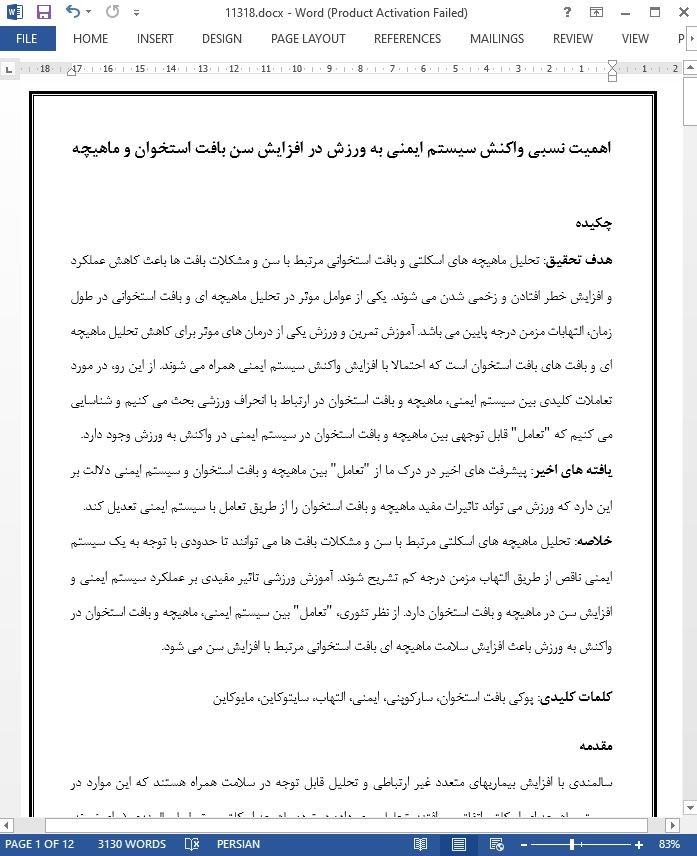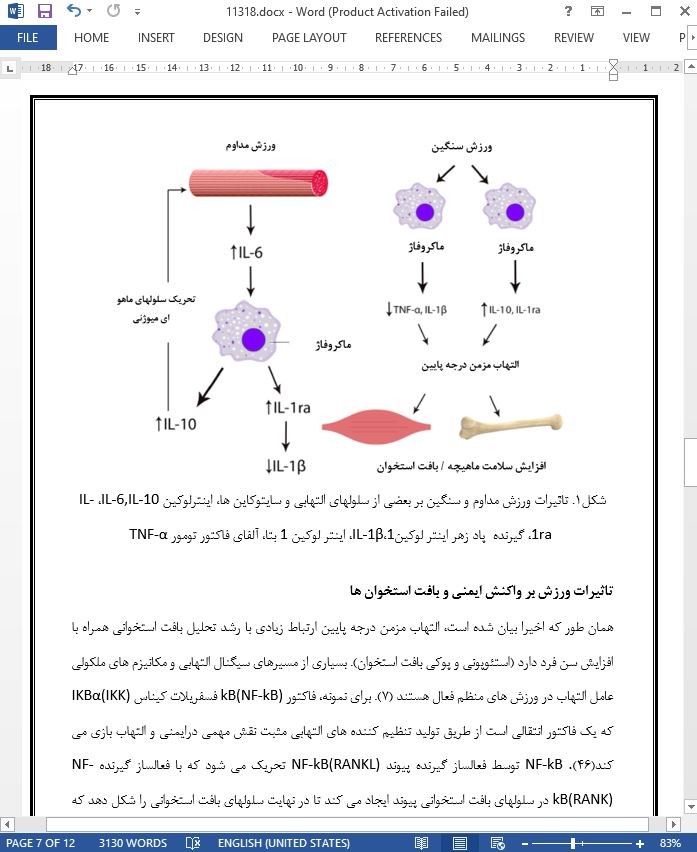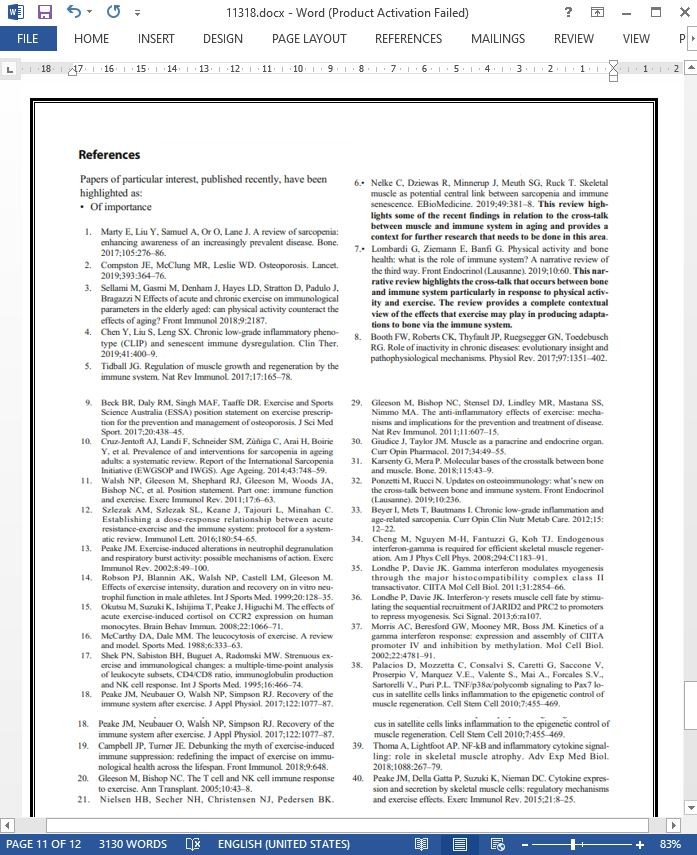
اهمیت نسبی واکنش سیستم ایمنی به ورزش در افزایش سن بافت استخوان و ماهیچه
چکیده
هدف تحقیق: تحلیل ماهیچه های اسکلتی و بافت استخوانی مرتبط با سن و مشکلات بافت ها باعث کاهش عملکرد و افزایش خطر افتادن و زخمی شدن می شوند. یکی از عوامل موثر در تحلیل ماهیچه ای و بافت استخوانی در طول زمان، التهابات مزمن درجه پایین می باشد. آموزش تمرین و ورزش یکی از درمان های موثر برای کاهش تحلیل ماهیچه ای و بافت های بافت استخوان است که احتمالا با افزایش واکنش سیستم ایمنی همراه می شوند. از این رو، در مورد تعاملات کلیدی بین سیستم ایمنی، ماهیچه و بافت استخوان در ارتباط با انحراف ورزشی بحث می کنیم و شناسایی می کنیم که "تعامل" قابل توجهی بین ماهیچه و بافت استخوان در سیستم ایمنی در واکنش به ورزش وجود دارد.
یافته های اخیر: پیشرفت های اخیر در درک ما از "تعامل" بین ماهیچه و بافت استخوان و سیستم ایمنی دلالت بر این دارد که ورزش می تواند تاثیرات مفید ماهیچه و بافت استخوان را از طریق تعامل با سیستم ایمنی تعدیل کند.
خلاصه: تحلیل ماهیچه های اسکلتی مرتبط با سن و مشکلات بافت ها می توانند تا حدودی با توجه به یک سیستم ایمنی ناقص از طریق التهاب مزمن درجه کم تشریح شوند. آموزش ورزشی تاثیر مفیدی بر عملکرد سیستم ایمنی و افزایش سن در ماهیچه و بافت استخوان دارد. از نظر تئوری، "تعامل" بین سیستم ایمنی، ماهیچه و بافت استخوان در واکنش به ورزش باعث افزایش سلامت ماهیچه ای بافت استخوانی مرتبط با افزایش سن می شود.
مقدمه
سالمندی با افزایش بیماریهای متعدد غیر ارتباطی و تحلیل قابل توجه در سلامت همراه هستند که این موارد در سیستم ماهیچه ای اسکلتی اتفاق می افتند. تحلیل روی داده در توده ماهیچه اسکلتی مرتبط با سالمندی (برای نمونه، یک عامل تعریف کننده پوکی بافت استخوان) بسیار شایع می باشد و شیوع سارکوپنی و پوکی بافت استخوان نیز بدون تردید با افزایش در میان جمعیت سالمند افزایش می یابند(1و2). یکی از عوامل موثر در تحلیل ماهیچه ای و بافت استخوانی در طول زمان، تغییر/ اختلال در عملکرد سیستم ایمنی است که تحت عنوان "التهاب سنی"(3) نامیده می شود که واکنش های مزمن موجود در بسیاری از شرایط و بیماریها را توصیف می کند (4). آموزش ورزشی می تواند یک اقدام موثر باشد. به هر حال، تاثیرات مکانیکی ورزش بر "التهاب سنی" نا مشخص هستند.
نتیجه گیری
در حالی که از رابطه بین سیستم ایمنی، ماهیچه و بافت استخوان در واکنش به ورزش درک وجود دارد، اما تحقیقات انجام شده در این حوزه محدود هستند و تحقیقات بیشتر تضمین شده است. بخصوص اینکه، شناسایی نوع، مقدار، تراکم و فراوانی ورزش های مختلف بر تاثیر گذاری بر واکنش سیستم ایمنی و چگونگی تاثیر آنها بر ماهیچه و بافت استخوان در یک حوزه بخشی از تحقیقات آینده هستند. همچنین، شناسایی شباهت ها و اختلافات در واکنش سیستم ایمنی، و تعامل آن با ماهیچه و بافت استخوان، بین وضعیت آموزشی و غیر آموزشی از موضوعات مورد علاقه هستند. همچنین، آیا قدرت یک واکنش در حالت آموزشی ثابت می ماند و یا حتی تقویت می شود؟ درک تاثیرات آموزش ورزشی بر تعامل بین سیستم ایمنی و بافت استخوان و یا ماهیچه در افراد بیمار یکی از حوزه هایی است که باید همچنان مورد بررسی های بالینی و پیش بالینی و تلاشهای تحقیقی قرار بگیرد. این تعاملات برای حفظ سلامت ماهیچه ای بافت استخوانی افراد لازم می شوند.
Abstract
Purpose of Review The age-related loss of skeletal muscle and bone tissue decreases functionality and increases the risk for falls and injuries. One contributing factor of muscle and bone loss over time is chronic low-grade inflammation. Exercise training is an effective countermeasure for decreasing the loss of muscle and bone tissue, possibly by enhancing immune system response. Herein, we discuss key interactions between the immune system, muscle, and bone in relation to exercise perturbations, and we identify that there is substantial “cross-talk” between muscle and bone and the immune system in response to exercise.
Recent Findings Recent advances in our understanding of the “cross-talk” between muscle and bone and the immune system indicate that exercise is likely to mediate many of the beneficial effects on muscle and bone via their interactions with the immune system.
Summary The age-related loss of muscle and bone tissue may be partially explained by an impaired immune system via chronic low-grade inflammation. Exercise training has a beneficial effect on immune system function and aging muscle and bone. Theoretically, the “cross-talk” between the immune system, muscle, and bone in response to exercise enhances aging musculoskeletal health.
Introduction
Aging is associated with the development of a variety of noncommunicable diseases with some of the most significant deteriorations to health happening in the musculoskeletal system. The age-related loss of skeletal muscle mass (i.e., one defining factor of sarcopenia) and bone tissue (i.e., one defining factor of osteoporosis) is highly prevalent, and the incidence of sarcopenia and osteoporosis will inevitably increase with the growing (and aging) population [1, 2]. One main contributing factor of muscle and bone loss over time is altered/impaired immune system function, referred to as “inflammaging” [3] which describes the low-level chronic inflammatory response that exists in many aged conditions and diseases [4]. Exercise training may act as a countermeasure; however, the mechanistic effects of exercise on “inflammaging” are relatively unknown.
Conclusion
While there is some understanding of the inter-relationship between the immune system, muscle, and bone in response to exercise, research is limited and additional work is warranted. Specifically, identifying the types, doses, intensities, and frequencies of various exercise modalities on influencing the immune system response and how this influences bone and muscle is an area apt for future research. Also, identifying the similarities or differences in the acute response of the immune system, and its cross-talk with muscle and bone, between an un-trained and trained state is of interest. Will the strength of the response remain, or even be more robust, in a trained state? Understanding the effects of exercise training on the cross-talk between the immune system and bone or muscle in diseased populations is an area that should continue to undergo pre-clinical and clinical research efforts. These interactions are essential for maintaining musculoskeletal health as individuals’ age.
چکیده
مقدمه
واکنش سیستم ایمنی به ورزش
تاثیرات ورزش بر واکنش ایمنی و ماهیچه های اسکلتی
تاثیرات ورزش بر واکنش ایمنی و بافت استخوان ها
نتیجه گیری
Abstract
Introduction
Immune System Response to Exercise
Effects of Exercise on Immune Response and Skeletal Muscle
Effects of Exercise on Immune Response and Bone
Conclusion
- اصل مقاله انگلیسی با فرمت ورد (word) با قابلیت ویرایش
- ترجمه فارسی مقاله با فرمت ورد (word) با قابلیت ویرایش، بدون آرم سایت ای ترجمه
- ترجمه فارسی مقاله با فرمت pdf، بدون آرم سایت ای ترجمه



